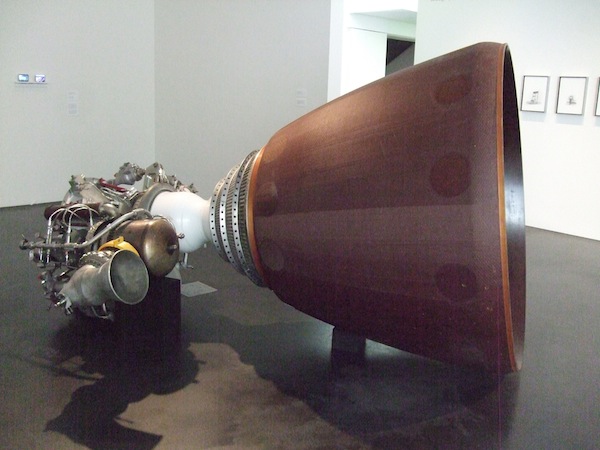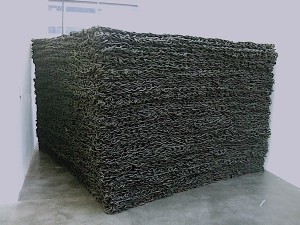
Art Review: Energy Effects at MCA Denver The Art and Fictions of Excess
Is a Titan IV Stage II rocket engine a work of art? It was designed to fly to Saturn, but never made the journey. How about a B61 Thermonuclear Bomb? According to Adam Lerner and Paul Andersen, curators of Energy Effects: Art and Artifacts from the Landscape of Glorious Excess “nuclear weapons are designed to produce fear, and thereby they are made specifically to prevent their own use.” Try telling that to the citizens of Hiroshima and Nagasaki. Or Colin Powell who was convinced that Saddam Hussein harbored weapons of mass destruction in Iraq. The curators go on to suggest that the enormous amount of energy it takes to create something functional, but designed not to be used, makes them similar to art? Yes, it takes an enormous amount of energy to create a work of art, but art is not made to specifically prevent its own use, and neither are nuclear weapons. The eureka moment of discovery for a scientist is very similar to that pure moment of creative discovery for an artist. But the similarities end there. Perhaps Lerner and Andersen could never envision themselves using a nuclear weapon, but in 1945 after detonating the first atomic bomb at the Trinity test site in New Mexico, J. Robert Oppenheimer famous declared: “Now I am become Death, the destroyer of worlds.”
Six years earlier in 1939, when nuclear fission was first discovered “no one envisioned a bomb immediately. It took a couple of weeks!” artist Jim Sanborn said in an interview with Lerner in the REPORT From the Dept of Fabrications i.e., the MCA Denver newsletter. “In general, it was a period for pure science.” But pure science is as elusive as pure art. The moment is fleeting and then the discovery, the creation becomes a weapon, a product, a commodity.

Sanborn spent $50,000 and nearly six years creating a functioning replica of the first particle accelerator built by Niels Bohr and Enrico Fermi. His artwork, “Terrestrial Physics” was completed with the help of NASA engineer Steve Brown and tested at his studio on a 15-acre island beyond Piney Point, MD generating 1.5 million volts of static electricity and achieving nuclear fission. Brown didnt know why Sanborn wanted to achieve nuclear fission. He told Blake Gopnik of the Washington Post: “My initial reaction was, Sounds like a lot of work, and what are you going to get out of it in the end? ” Then Brown started thinking in fine-art terms, and determined it wasnt much different than a Dutch still life. Assembling some fruit, flowers and a ceramic bowl is the same as building a particle accelerator?
Lerner is quoted in Gopniks article as well ruminating on Sanborns creation. “Its a kind of “˜found-object art, but where the artist makes the object before finding it. Its as though Andy Warhol were to have built a Campbells Soup factory and had started making tomato soup.”
But then wouldnt Andy Warhol have been a soup manufacturer and not an artist? What if he had been a soup manufacturer? Making Warhol brand tomato soup and then creating screen prints of his Warhol brand soup? Would the art have had an impact then? Isnt the fact that Warhol took a major corporate brand, something everyone had in their kitchen and turned it into art what made it art? If thats the case, then is Rob Dyrdeks worlds largest functioning skateboard a work of art? Or was the attempt to ride the worlds largest skateboard a performance work? If, as Sanborn say, his particle accelerator is the ultimate in realistic art because he is confronting people with the real shit, then Warhol soup prints and Dyrdeks skateboard are equally real, as real as the video feed of oil gushing up from the bottom of the Gulf of Mexico. And if weve come so far that artists have to get our attention by creating the real thing, does that mean we will see actual war, rape and abuse reinacted as art? Damien Hirst will now have to become a butterfly farmer before he embeds blue butterflies in pink paint?
Energy Effects, began with an idealogical position and not an interest in a specific artist or genre. Cultures have more energy than they need to sustain life and how they use their excess energy is what defines that culture. “Energy Effects explores how abundant space, power, speed, effort, and time become the raw material of art and industry,” Lerner writes in the REPORT. So it is the energy that is the raw material of art. The energy that Sanborn used to create energy, thats the art. The energy that Warhol used. Thats the art. When I interviewed Andersen in June he told me that he and Lerner looked for art that worked on two levels. It either had to take a lot of energy to make and/or the content had to deal with popular notions of energy or had to have a particular sensibility of energy.

What saves this exhibit from being intellectually esoteric to a fault is that interspersed throughout is some actual art. My initial reaction was that it is a boys show, filled with boys toys like rockets, engines, and mechanical works, cars, gas pumps, and particle accelerators. Yet, I immediately paused and thought of Viviane Le Courtois “Chaussures” featuring 125 pairs of used hand made sandals that the artist wears until they literally fall apart. “I constantly create art, by creating sculpture with the act of walking, eating, and living,” she writes in her artist statement. The energy to live. Thats her art. And Ciro Najles “Cumulus” an inkjet print diagram recreated in crochet hanging from the ceiling of the atrium. Martha Russos “Shibumi” ornamental objects, created by dipping everyday objects and detritus into clay slip and firing, that appear to be blown into a back corner near the stairway and Gonzala Lebrijos disturbing yet fascinating video made from the window of his Guadalajara apartment following a soccer match, of men attempting to and succeeding in groping women. The soundtrack is Aranjuez the song traditionally played during the running of the bulls. As one watches it becomes unclear which of the men are the aggressors and which are the protectors. Energy is non-gender specific.
In the end, I think the idealogical position is intriguing and some of the work is compelling visually and intellectually. One can see Anish Kapoor echoed in the Lockheed Martin engine. Marvel at the placement of Orly Gengers “Reg” a large cube made from thick, black rope that blocks a main corridor in the building. Ponder Ward Shelleys “Autobiography ver. 1″ 2006 which diagrams the artists life and links to the important figures and key concepts from art history and the avant gard. That said, Im still not convinced in the theory that art is energy and particularly energy without function. That the pure moment of creation can somehow be captured and held. I do, however, embrace the idea that these objects represent the art and artifice of glorious excess.

Thank you, thank you for taking a moment to challenge the idea that placement in the art context equals art. I did find the missiles very impactful to experience, and wanting them to be art despite lacking so many reasonable qualifications.
I’d put Sanborn’s “Terrestrial Physics” in the realm of history painting.
Leanne, as usual you make a lot of very valid comments (and your ‘R&D’ remains second to none). Still, I see this in 2 perspectives: first of all, these objects are far in excess artistically of many of the more ‘modern’ pieces I’ve seen over the past years. One could even argue against the approach of Christo or any of the ‘found object’ designers of our day. Secondly, and here no amount of higher education will help, the…